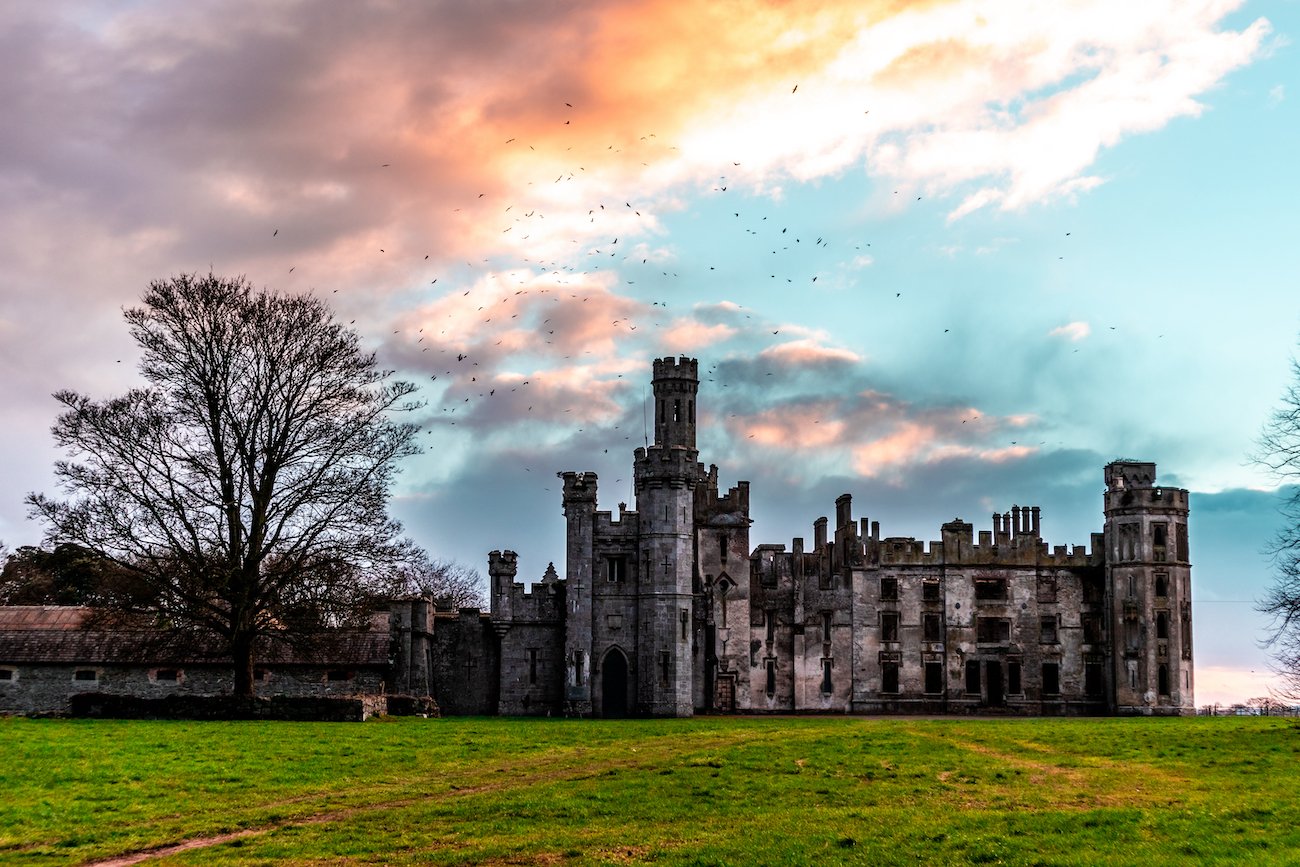I’ve visited a lot of ruins in Ireland. They seem to attract me but they also inspire ideas for my novels. I wrote about a few of these old houses before in ‘Scrapbook’ such as Moore Hall, Dunluce Castle, and also some of the more ghostly ones like Loftus Hall and Leap Castle, but if I were asked to pick a favourite ruin to walk around, I would have to choose Duckett’s Grove in County Carlow.
A spectacular arrival
The approach to Duckett’s Grove is nothing short of spectacular. In fact, there are two approaches, one via the main avenue underneath a Victorian Gothic arched gateway and the other, which was presumably a back entrance, where we drive along a narrow road, turn a bend and suddenly the house, in all its ruinous splendour, appears. I like both avenues but the second is the most dramatic way to arrive.
The mansion is a wonderful example of the Victorian Gothic Revival period where extraordinary and extravagant additions where added to plainer Georgian buildings, including towers, finials, carved stone gargoyles and turrets. They all abound at Duckett’s Grove!
This is the view of Duckett’s Grove when you round the bend. The spectacular ruin suddenly appears.
A brief and rather tragic FAMILY history of the Ducketts
The Duckett family arrived from England during the Cromwellian period in Ireland in the 1650s but the original house wasn’t built on this site in County Carlow until the 1700s. The turning point for the wealth of the family came in 1790 when a William Duckett married Elizabeth Dawson Coates, daughter of a rich banker from Dublin. They had four sons and two daughters, and their first son, named John Dawson Duckett, inherited Duckett’s Grove.
As was often the case during those centuries without modern medicine and antibiotics, people died young and the Dawson Duckett family tomb at Rutland Church in Carlow tells a sad tale. The second son of John Dawson Duckett, William, lived to the age of 70 but his wife died at 35 and, five years later, a son tragically passed away at the age of 12 on Christmas day in 1857.
In November 1895 William’s other son, another William, married his second wife, a 21 year old widow when he was 75! Apparently there was a wonderful celebration when the newlyweds arrived at the gates of Duckett’s Grove. The local tenants removed the horses from the carriage and, putting themselves in the shafts, pulled the family up the avenue. Fireworks lit up the sky, there was dinner and dancing for all, and the new Mrs Maria Georgina Duckett gave a talk about magic lanterns in the coach house. I’d love to be able to whisk myself back in time to see all that.
Architectural elements from the Victorian Gothic Revival period abound at Duckett’s Grove with towers, finials, gargoyles and turrets added during the 19th century.
The demise of Duckett’s Grove
So what happened? How did the fortunes of the Dawson Duckett family go downhill so quickly after the end of the 19th century? Following William’s death, Maria inherited the Gothic mansion but she fell out with some of the locals and moved to Dublin and afterwards spent little time in Carlow. The house was occupied by the Irish Republican Army during the War of Independence and became a training ground. Stories abound about soldiers using the statues for target practice and two female revolutionaries, who escaped from Mountjoy Jail in Dublin, were allegedly hidden at Duckett’s Grove.
Another strange tale is of the ‘Angry Shilling’. Maria returned to Ireland from England and, suffering from mental ill-health, she fell out with her only daughter Olive and declared in her Will that she was to receive one shilling. Olive contested the Will in 1939 but unfortunately the judge upheld it and her mother’s money ended up going to various charities. Olive got nothing - apart from that bitter shilling. That was the end of the Duckett family at Duckett’s Grove. The house was eventually left empty and one night went on fire. The burning of the house is also a mystery. There are various rumours but I’ve never heard anything conclusive.
There are many tales of ghosts at Duckett’s Grove and it’s a haven for paranormal enthusiasts
Ghostly tales but a great place to visit
There are, of course, many stories of ghosts at the Gothic ruin and it’s not a place I’d like to visit at night. Plenty braver than me have! There’s supposed to be a ghostly William Duckett on horseback who rides around the grounds, another member of the family appears in a room overlooking the yard and I even heard tales of a pack of hounds being seen. A curse was supposed to have been placed on the family by the mother of a young woman who had an affair with one of the Ducketts and died after a fall from her horse on the estate. This curse apparently takes the form of a banshee which screeches at night throughout the burnt out rooms. The property is, of course, a haven for paranormal enthusiasts.
Duckett’s Grove is a lovely place to walk. It’s now owned and managed by Carlow County Council and has two 18th century adjoining red-brick walled gardens and a coffee shop.
Carlow County Council owns Duckett’s Grove now, looks after the gardens and holds various functions there, including candlelit concerts. It’s a fabulous and dramatic place for a walk, with its two 18th century adjoining red-brick walled gardens. I’m told there’s a new coffee shop so I hope to go back again soon!
Suzanne Winterly is the author of mystery and dual timeline historical mystery novels set in the late 19th century and in the present. More details below:
For more about books, stories and photographs, author research, history and gardening, join Suzanne’s newsletter here:




